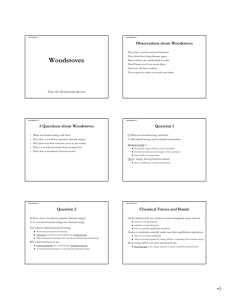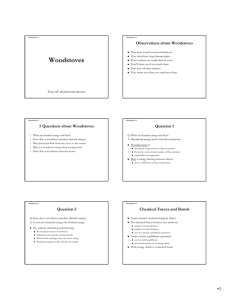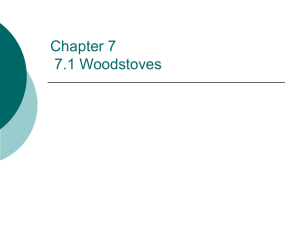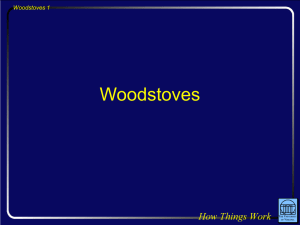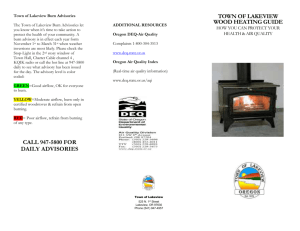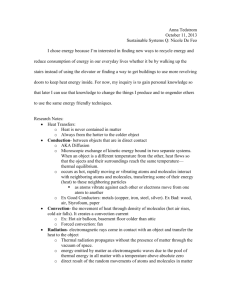Stoves and Lightbulbs
advertisement
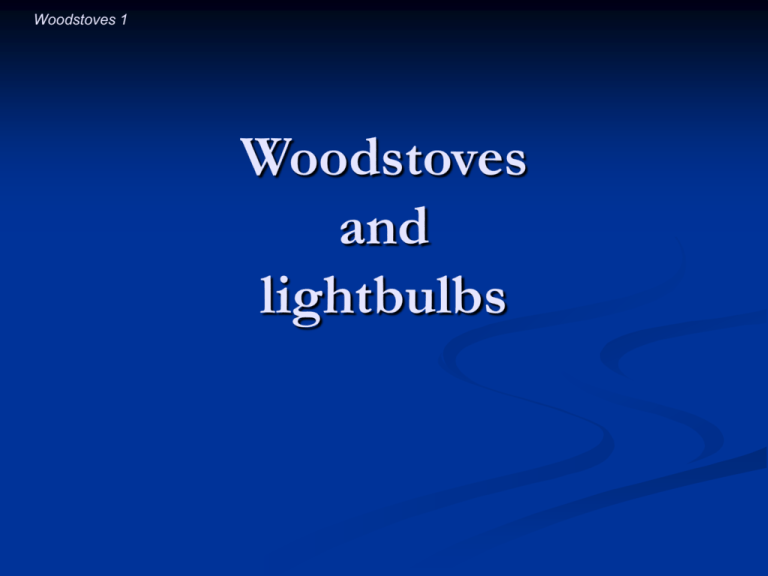
Woodstoves 1 Woodstoves and lightbulbs Woodstoves 2 Introductory Question Which is more effective at heating a room: A. a black woodstove a shiny chrome-plated woodstove B. Woodstoves 5 Question 1 What are thermal energy and heat? Woodstoves 6 Having Thermal Energy Thermal energy is disordered energy within an object kinetic and potential energies of atoms is responsible for temperature Thermal energy doesn’t include order energies kinetic energy of an object moving or rotating potential energy of outside interactions Woodstoves 7 Transferring Heat Heat is energy that flows between objects because of their difference in temperature thermal energy on the move Woodstoves 8 Question 2 How does a woodstove produce thermal energy? Woodstoves 9 Burning Wood Fire releases chemical potential energy Wood and air consist of molecules Molecules are bound by chemical bonds When bonds rearrange, they can release energy Burning rearranges bonds and releases energy! Woodstoves 10 Chemical Forces and Bonds Atoms interact via electromagnetic forces The chemical forces between two atoms are attractive at long distances repulsive at short distances zero at a specific equilibrium separation Atoms at the equilibrium separation are in a stable equilibrium and are bound together by an energy deficit Woodstoves 12 Chemical Reactions Breaking old bonds takes work Forming new bonds does work If new bonds are stronger than old, chemical potential energy thermal energy Breaking old bonds requires energy reaction requires activation energy to start Woodstoves 14 Question 3 Why does heat flow from the stove to the room? Woodstoves 15 Heat and Temperature Heat always flows from hotter to colder This flow direction is an overall statistical result Microscopically, thermal energy moves both ways At thermal equilibrium the temperatures of the objects are equal and no heat flows between those objects Temperature is approximately the average thermal kinetic energy per particle Woodstoves 16 Question 4 Why is a woodstove better than an open fire? Woodstoves 17 An Open Fire Burns wood to release thermal energy It has good features: Heat flows from hot fire to cold room But it also has bad features: Smoke enters room Fire uses up room’s oxygen Can set fire to room Woodstoves 19 A Woodstove Burns wood to release thermal energy It has good features: Heat flows from hot fire to cold room All the smoke goes up chimney pipe New oxygen enters room through cracks Relatively little fire hazard Transfers heat efficiently to room Woodstoves 21 Question 5 How does a woodstove heat the room? Woodstoves 22 Heat Transfer Mechanisms Conduction: heat flow through materials Convection: heat flow via moving fluids Radiation: heat flow via light waves All three transfer heat from hot to cold Woodstoves 23 Conduction and Woodstoves Heat flows but atoms don’t In an insulator, adjacent atoms jiggle one another atoms do work and exchange energies on average, heat flows from hot to cold atoms In a conductor, mobile electrons carry heat long distances heat flows quickly from hot to cold spots Conduction moves heat through stove’s walls Woodstoves 24 Convection and Woodstoves Fluid transports heat stored in its atoms Fluid warms up near a hot object Flowing fluid carries thermal energy with it Fluid cools down near a cold object Overall, heat flows from hot to cold Convection circulates hot air around the room Woodstoves 25 Radiation and Woodstoves Heat flows by electromagnetic waves (radio waves, microwaves, light, …) Wave types depend on temperature cold: radio wave, microwaves, infrared light hot: infrared, visible, and ultraviolet light Higher temperature more radiated heat Black emits and absorbs light best Woodstoves 26 Stefan-Boltzmann Law The amount of heat a surface radiates is power emissivity Stefan-Boltzmann constant temperature4 surface area where emissivity is emission efficiency Emissivity 0 is worst efficiency: white, shiny, or clear 1 is best efficiency: black Radiation transfers heat to your skin as light Woodstoves 27 Introductory Question (Revisited) Which is more effective at heating a room: A. a black woodstove a shiny chrome-plated woodstove B. Woodstoves 29 Thermal Radiation All materials emit thermal radiation All materials contain electric charges Thermal energy causes those charges accelerate Accelerating charges emit electromagnetic waves Hotter temperatures yield shorter wavelengths Woodstoves 30 An Incandescent Lightbulb Light is emitted by a hot tungsten filament Electric wires deliver power to the filament Glass bulb protects the filament Inert gas fill prolongs filament’s life Woodstoves 31 Black Body Spectrum The spectrum and intensity of electromagnetic waves from a black body depend only on its temperature Temperature determines the color. Visible efficiency increses with temp. Bulb’s lifetime decreses with temp. Woodstoves 32 What determines a lightbulb’s brightness? • Lightbulb filament maintains zero net power •Its thermal power out must equal electrical power in •Its radiated power increases with its electrical power •Its radiated power increases with its surface area • Higher wattage bulbs • use larger filaments with more surface area • maintain the usual 2500 C filament temperature • and radiate more visible light as a result Woodstoves 33 Why do lightbulbs eventually burn-out? Filament requirements are challenging Filament must remain solid to high temperatures Filament must experience minimal sublimation Filament must be electrically conducting Tungsten metal is the best filament material Tungsten remains solid to 3422 °C Tungsten sublimes relatively slowly at 2500 °C Tungsten conducts electricity Woodstoves 34 Summary Woodstoves use all three heat transfer mechanisms Have tall chimneys for heat exchange Are black to encourage radiation Are sealed to keep smoke out of room air Lightbulbs emit visible thermal radiation Most of their thermal radiation is invisible They fail when the filament sublimes away
